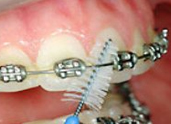Oral Hygiene
Brushing & Flossing Procedures
Food particles and plaque naturally accumulate on the teeth and on braces. This process could lead to tooth decay and/or gum disease. Proper oral hygiene is vital to prevent these problems from occurring during your orthodontic treatment. The extra effort you give to keep your teeth, braces and gums clean and healthy will result in a much better orthodontic outcome.
BRUSHING
We recommend that you use a soft bristled toothbrush with moderate force and a toothpaste that contains fluoride. Place the toothbrush at an angle so that you feel the bristles under your gum line and use small circular motions. Completely clean each surface of every tooth in your mouth, including the areas above, below and between each brace. Each surface of every tooth should be scrubbed with 10 strokes of the toothbrush. This should take 2-3 minutes.
We recommend that you brush at least 4 times per day: after breakfast, after lunch (or as soon as you get home from school), after supper and at bedtime. Your toothbrush will wear out faster because of your appliances, so be sure to replace it whenever the bristles start to fray.
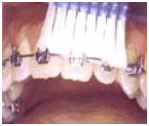
1. Use a soft toothbrush with a small amount of toothpaste. Completely clean each surface of every tooth in your mouth, including the areas above, below and between each brace.
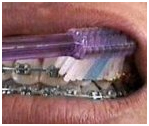
2. Brush every tooth slowly. Brush the upper teeth down.
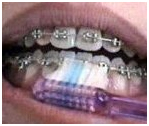
3. Use circular, vibrating motions around the gum line. Scrub each surface of every tooth with 10 strokes of the toothbrush. This should take 2-3 minutes.
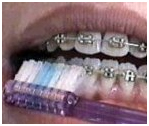
4. Brush the lower teeth up. Also brush your tongue and the roof of your mouth.
Remember that a toothbrush might not reach the areas under the archwire properly. Proper oral hygiene also involves flossing and the use of an interdental toothbrush.
FLOSSING
Dental floss is a nylon thread that is used to remove food particles and plaque from between the teeth. Flossing is more difficult when you have braces on your teeth. Slide the floss up and down along the tooth surface. Be very careful to not pull with too much force on your archwire during this procedure. Daily flossing is essential to your dental health. Often neglected, flossing helps improve the overall health of your teeth and gums. Flossing assists in cleaning many of the "hard to reach" spots in your mouth, spots that regular brushing generally misses. By flossing, you alleviate much of the plaque buildup that often causes gum disease. Although flossing is more difficult with braces, it is critical to your orthodontic treatment. Always floss at least twice a day: once after lunch, and once before bedtime. Proper flossing reduces the risk of periodontal disease and tooth decay.
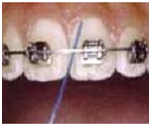
1. Carefully pull floss between gum and tooth
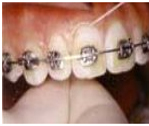
2. Carefully pull floss between gum and tooth
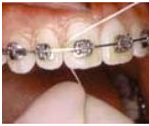
3. Floss carefully around each tooth.
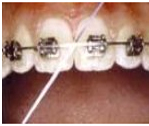
4. Floss carefully around the braces.
INTERDENTAL TOOTHBRUSH
An interdental toothbrush is another aid you may find useful to keep your teeth, braces and gums clean and healthy. It can be used to clean under orthodontic wires and around braces. Use this device slowly so you do not damage your braces.
